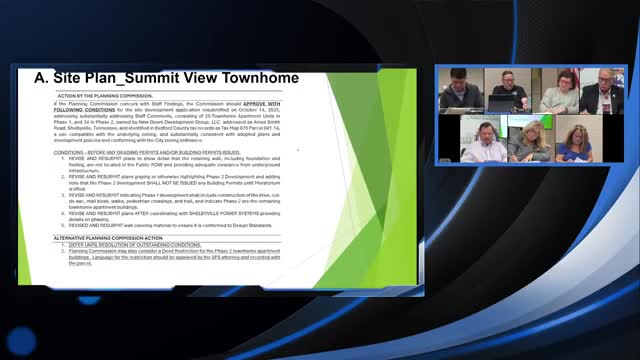Planning Commission issues unfavorable recommendation for Ridgetown Lane rezoning amid character, access and infrastructure concerns
October 24, 2025 | Planning Commission Meetings, Shelbyville, Bedford County, Tennessee
This article was created by AI summarizing key points discussed. AI makes mistakes, so for full details and context, please refer to the video of the full meeting. Please report any errors so we can fix them. Report an error »

The Planning Commission voted to forward an unfavorable recommendation to city council on a rezoning request for about 57.56 acres along Ridgetown Lane and Fairfield Pike, concluding the change from R‑2 to R‑3 would materially alter neighborhood character and raise infrastructure concerns.
Applicant James D. Trollinger (trustee), represented by Lee Hancock, sought rezoning of a parcel currently zoned R‑2 (medium/low density residential) to R‑3 (medium density residential). Staff said the parcel is identified in the city’s future land‑use map as a mixed‑density residential character area; staff’s analysis noted public‑facility connections exist but also highlighted edge conditions where larger lots abut smaller lots and site constraints such as TVA powerline easements and stream buffer areas that reduce developable area.
During discussion, commissioners and members of the public raised concerns that approving R‑3 would permit higher densities than surrounding lots, allow duplexes in the future, and change the built character along the existing dead‑end cul‑de‑sac. Commissioners also questioned whether the higher density was appropriate at the edge of the city’s utility footprint and whether additional development would worsen traffic and school‑zone congestion near Cartwright Elementary.
Staff noted that concept plans submitted by the applicant show a lower realized unit count (about 156 in the concept plan) than the gross capacity figure produced by a straight zoning‑density calculation (about 250), citing stream buffers and TVA easements as constraining factors. The applicant said the concept plan anticipates those constraints and that the rezoning is needed to make the development financially viable and to provide a potential new connector to the bypass if access and right‑of‑way agreements can be secured.
After extended discussion, a commissioner moved that the planning commission recommend an unfavorable recommendation to city council. The motion carried; the commission’s action sends the rezoning with an unfavorable recommendation to city council for final consideration.
Why it matters: Rezoning decisions change the set of permitted uses and densities on a site. Commissioners framed this vote as a question about preserving the existing character of a long‑established neighborhood and the appropriateness of adding medium‑density lots at the edge of the city’s utilities and traffic network. The unfavorable recommendation does not veto the rezoning — it forwards the matter to the city council with the commission’s position for council consideration.
Applicant James D. Trollinger (trustee), represented by Lee Hancock, sought rezoning of a parcel currently zoned R‑2 (medium/low density residential) to R‑3 (medium density residential). Staff said the parcel is identified in the city’s future land‑use map as a mixed‑density residential character area; staff’s analysis noted public‑facility connections exist but also highlighted edge conditions where larger lots abut smaller lots and site constraints such as TVA powerline easements and stream buffer areas that reduce developable area.
During discussion, commissioners and members of the public raised concerns that approving R‑3 would permit higher densities than surrounding lots, allow duplexes in the future, and change the built character along the existing dead‑end cul‑de‑sac. Commissioners also questioned whether the higher density was appropriate at the edge of the city’s utility footprint and whether additional development would worsen traffic and school‑zone congestion near Cartwright Elementary.
Staff noted that concept plans submitted by the applicant show a lower realized unit count (about 156 in the concept plan) than the gross capacity figure produced by a straight zoning‑density calculation (about 250), citing stream buffers and TVA easements as constraining factors. The applicant said the concept plan anticipates those constraints and that the rezoning is needed to make the development financially viable and to provide a potential new connector to the bypass if access and right‑of‑way agreements can be secured.
After extended discussion, a commissioner moved that the planning commission recommend an unfavorable recommendation to city council. The motion carried; the commission’s action sends the rezoning with an unfavorable recommendation to city council for final consideration.
Why it matters: Rezoning decisions change the set of permitted uses and densities on a site. Commissioners framed this vote as a question about preserving the existing character of a long‑established neighborhood and the appropriateness of adding medium‑density lots at the edge of the city’s utilities and traffic network. The unfavorable recommendation does not veto the rezoning — it forwards the matter to the city council with the commission’s position for council consideration.
View full meeting
This article is based on a recent meeting—watch the full video and explore the complete transcript for deeper insights into the discussion.
View full meeting
